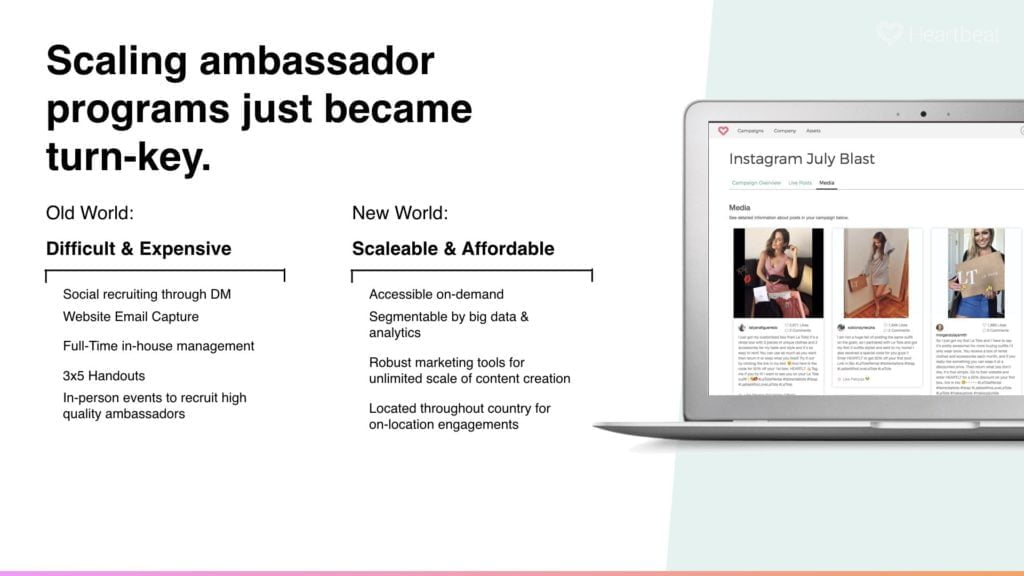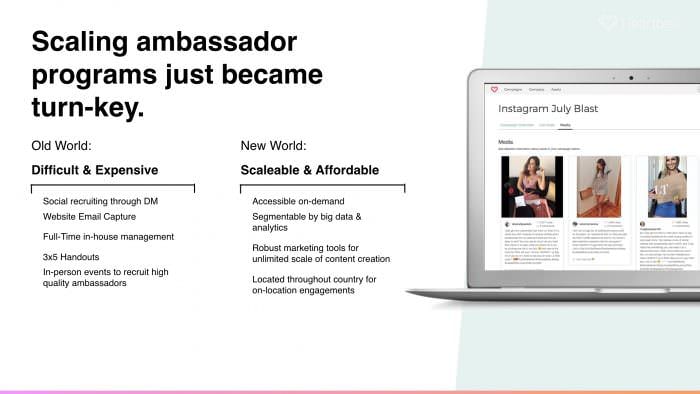Here’s how to attract more brand ambassadors and let your customers do the marketing for you
Many people — even professional marketers — confuse brand ambassador and influencer marketing. Although they share many traits, they are fundamentally different approaches and require different strategies to scale.
Influencers are paid, spokespeople. They create content for a short period of time on a contract, then often remove the content from their social media feeds after the contract ends.
Influencers have their uses, but for long-term impact, brand ambassadors offer superior ROI. Unlike influencers, brand ambassadors are unpaid customers. Their genuine love for a company and its products inspires them to share their passion, driving sales through word of mouth.
Any successful marketing strategy is worth continued investment. Brand ambassador programs are no different.
During test phases, marketers should not be concerned about scale — only evidence that a program works. Once the program proves effective, however, scale becomes a top priority. This poses challenges for brand ambassador programs. How can companies convince buyers, who have no financial stake in the brand’s success, to do their marketing for free?
Ambassador programs used to be more difficult to scale than influencer programs, but today’s strategies and tools make it easy to scale effectively and affordably. Word-of-mouth marketing is too effective to leave to chance, so marketers must give their ambassador programs the attention they deserve or risk losing satisfied customers to more engaging competitors.
The golden age of ambassadors
Thanks to the internet, social media, and increased data capabilities, companies have more options than ever to scale their brand ambassador programs.
In the past, ambassador programs relied on manual labor and individual connections. Marketers reached out to people individually through social media or captured email addresses through website forms. In-house teams had to maintain this churn constantly, slowly building followings with little insight into the connection between those fans and increased revenue.
New tools and big data make it easier to scale programs affordably. Thanks to tools with social media integration, marketers can split their audiences into countless demographics, identifying the people most likely to become ambassadors and personalizing messages to reach these receptive audiences. These conversations don’t occur in private messages — they take place in comment sections and other public places, reinforcing brand values while attracting new believers.
Even better, Millennials and members of Generation Z actively desire brand interaction. According to one study from the IBM Institute of Business Value, 60% of Gen Zers want brands to value their opinions, and 53% choose brands that understand them as individuals.
They crave authenticity, seeking out brands that reflect their self-images and championing companies that share their values. This lowers the barrier to entry for new ambassador programs, allowing any company with a webpage and a vision statement to recruit followers eager to spread the word.
Virtually every Millennial and older Gen Zer carries a smartphone, which helps brands build engagement on the go. One study from LivePerson found that, globally, 65% of these generations’ members interact with one another more online than they do offline. They are digital natives, constantly moving between the physical world and the electronic one, carrying brand messages across the barrier and into their conversations on both sides.
Now that these two generations make up 48% of the U.S. population, per Nielsen, brands must meet them on their own turf to ensure brand messages reach the largest audiences.
Challenges ahead
With new opportunities come new challenges. Email open rates for nontransactional communications remain low. Gmail and other mail systems automatically filter out rich HTML messages, relegating many scaling programs to the “Promotions” tab. Fortunately, new tools are helping marketers overcome these obstacles.
Tools such as SendForensics help marketers design stronger email campaigns. Using deliverability testing and other techniques, SendForensics helps marketers avoid looking like spam to email filters, getting more messages in front of potential ambassadors.
For e-commerce products, discovering interested parties’ email addresses becomes a challenge unto itself. Consumers are more interested in purchases, while companies want to drive future engagement without sacrificing immediate buys in the process — after all, is an ambassador helpful if he or she didn’t actually purchase your product? This puts an email-based ambassador program in direct competition with sales, hampering the ability of e-commerce sites to pad their lists.
All is not lost, though. Brands from the e-commerce industry to the B2B space can still build and scale effective, affordable ambassador programs by following these strategies:
1. Use tools to create a double opt-in.
To boost low open rates, simplify HTML emails through double opt-in tactics. Companies still face deliverability hurdles, but consumers who actively express interest are much easier to engage.
MailChimp, for example, offers a double opt-in feature, asking new subscribers to confirm their commitment to an email list. Use tools like this one to maximize deliverability and create double opt-in processes that ensure every email list member is a potential ambassador.
2. Get cellphone numbers
Consumers ignore emails far more easily than they ignore text messages. Ask for — and verify — cell phone numbers to send a few mass text messages to ambassadors. With a light touch, these messages have a far greater impact than comparable emails.
Verified text messages offer deliverability rates near 100 percent, with high conversion rates as well. Euphoria Fest, a music festival, sent a 25 percent ticket discount through three texts to interested ambassadors, achieving a conversion rate 10 times higher than its past email campaigns.
3. Recruit after the sale
After you complete transactions, stay at the top of consumers’ minds by offering chances to join your ambassador program after the purchase. Time these messages to give people a chance to use the product or service, hitting them at the height of their interest to boost the chance of securing a new ambassador.
Add “Join Our Ambassador Team” buttons to all follow-up emails, in email receipts, and in any other future conversations you have. Provide incentives, such as referral discounts, to encourage ambassadors to spread the word and recruit their friends.
Nothing bests free marketing, especially when it’s as effective as a brand ambassador program. Follow these tips to scale a few ambassadors into an army of brand loyalists.

